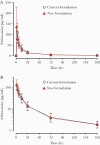Kimyrsa, An Oritavancin-Containing Product: Clinical Study and Review of Properties
- PMID: 35392455
- PMCID: PMC8982769
- DOI: 10.1093/ofid/ofac090
Kimyrsa, An Oritavancin-Containing Product: Clinical Study and Review of Properties
Abstract
Background: There is a need for improved antibiotic formulations for the treatment of acute bacterial skin and soft structure infection (ABSSSI), especially with the rise of antimicrobial resistance among Gram-positive bacteria. A new formulation of oritavancin was developed to reduce intravenous infusion volume (from 1000 mL to 250 mL), shorten infusion time (from 3 hours to 1 hour), and provide pharmacies with flexibility in oritavancin preparation (from 5% dextrose in sterile water to either normal saline or 5% dextrose in sterile water) compared with the current formulation.
Methods: A total of 102 adult patients with a diagnosis of ABSSSI suspected or confirmed to be caused by a Gram-positive pathogen were randomized 1:1 to receive either the new formulation of oritavancin or the current formulation. After a single 1200-mg intravenous infusion of oritavancin, the relative area-under-the-curve exposure of the new formulation and current formulation groups were compared. Safety and tolerability of the new formulation were assessed for treatment-emergent adverse events, serious adverse events, and changes to laboratory parameters.
Results: The area under the curve for 0 hour to 72 hours postdose was very similar in the new formulation group compared with the current formulation group. No differences in treatment-emergent adverse events were observed between the current and new formulation groups, and all treatment-emergent adverse events were consistent with the known safety profile of the current formulation.
Conclusions: The new formulation of oritavancin with reduced volume and duration of intravenous infusion demonstrates a safety profile and pharmacokinetics similar to that of the original formulation.
Keywords: ABSSSI; oritavancin; pharmacokinetics; skin infections.
© The Author(s) 2022. Published by Oxford University Press on behalf of Infectious Diseases Society of America.
Figures
References
-
- Garau J, Ostermann H, Medina J, et al. . Europe (2010-2011): assessment of clinical practice patterns and real-life effectiveness of antibiotics from the REACH study. Clin Microbiol Infect 2013; 19:E377–85. - PubMed
-
- Klein EY, Sun L, Smith DL, Laxminarayan R.. The changing epidemiology of methicillin-resistant Staphylococcus aureus in the United States: a national observational study. Am J Epidemiol 2013; 177:666–74. - PubMed


